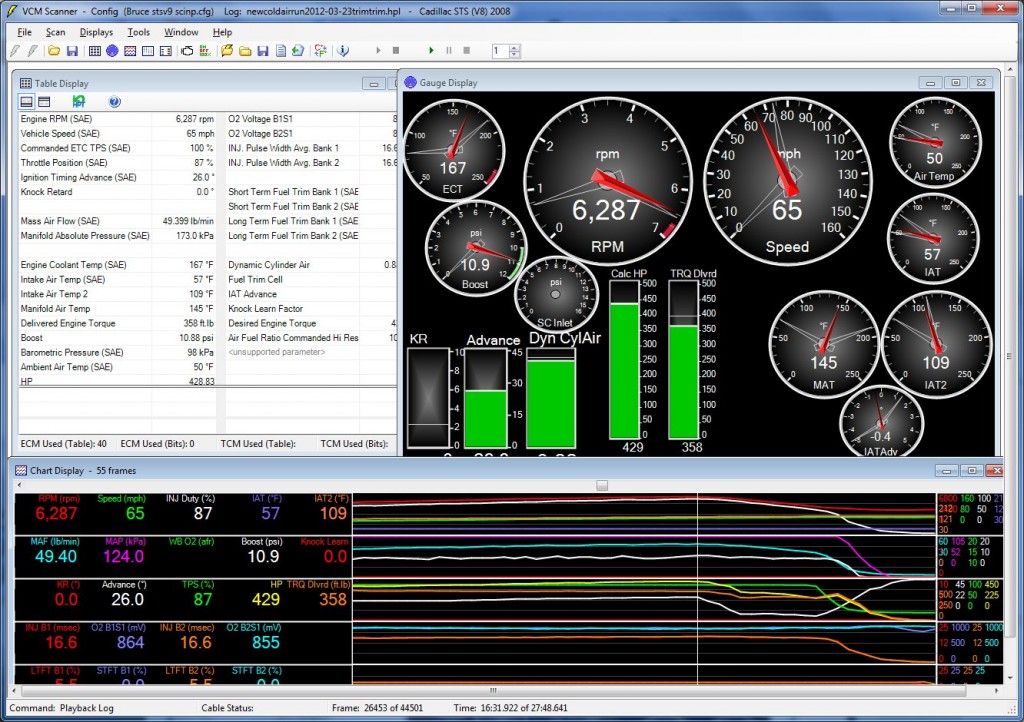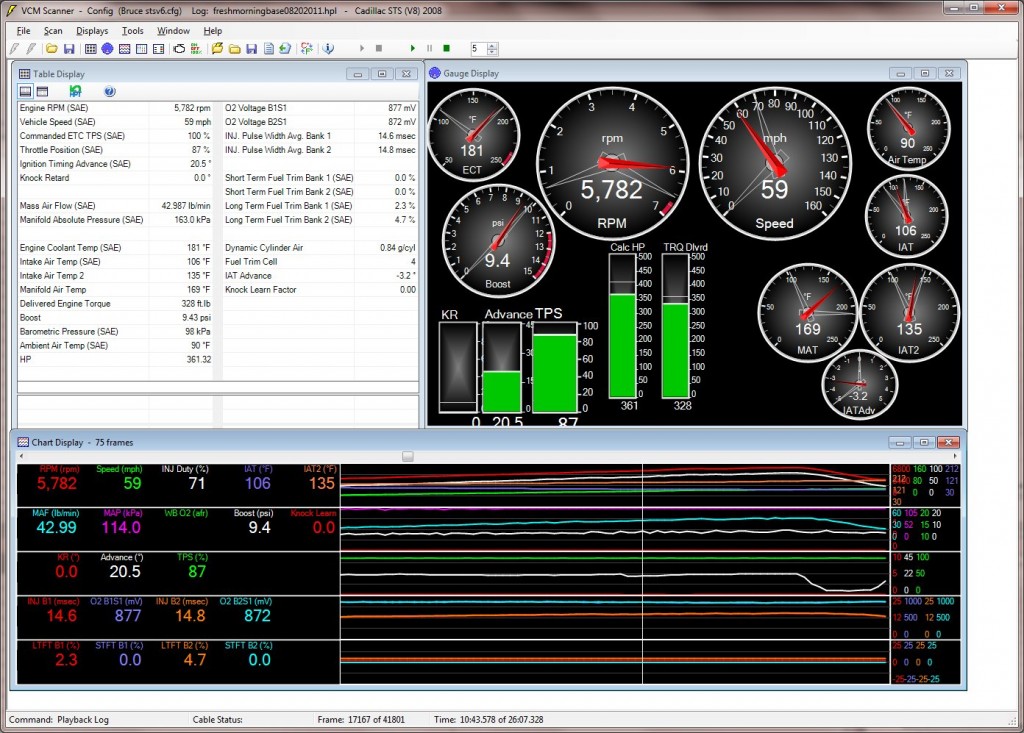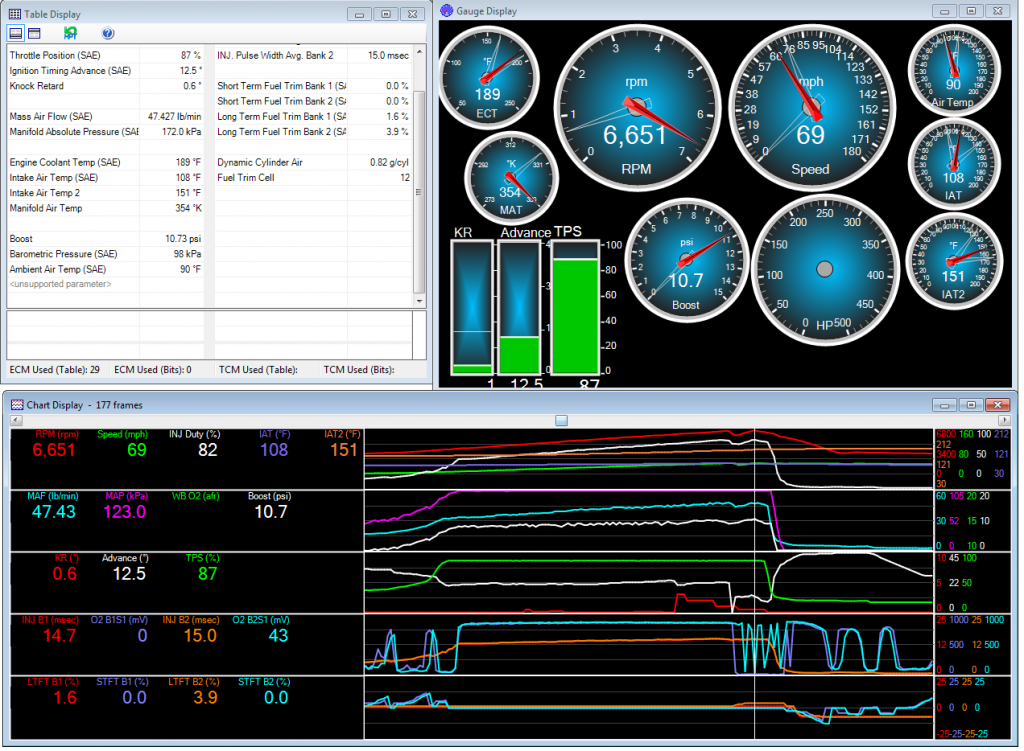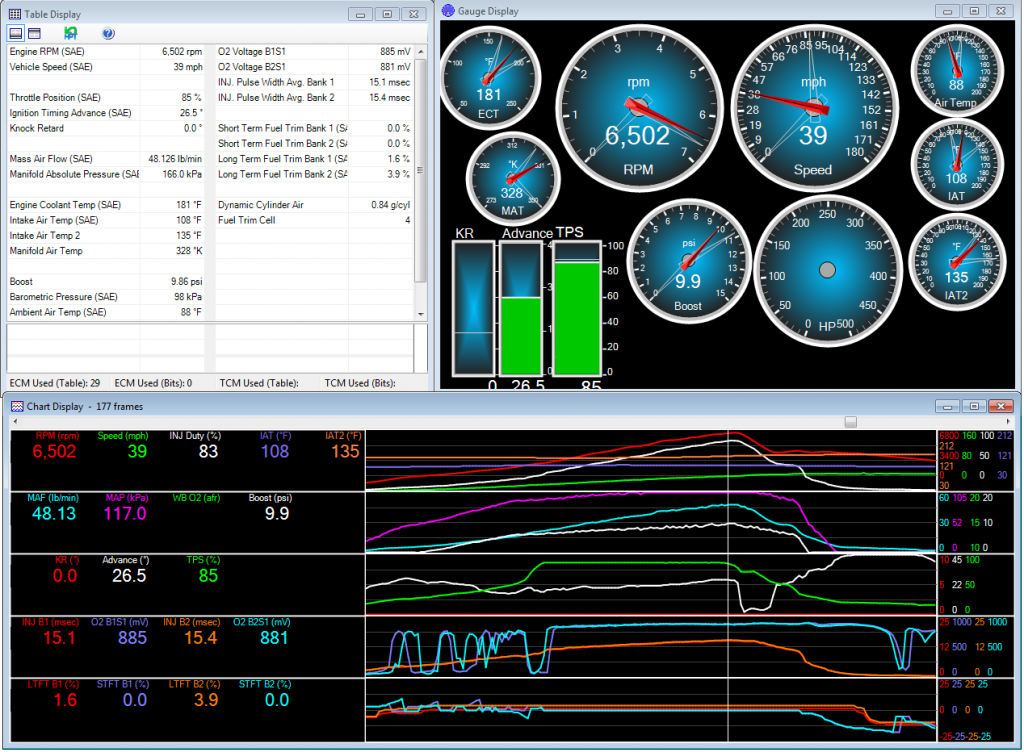We had a last glimpse of colder weather today so I did a new baseline for my 2008 Cadillac STS-V with Spectre cold air intake.
Low on fuel, forecast 45.6F, Baro 30.05
Lost some of the data on the PerformanceBox — the text files captured properly, but the dbn full datafile did not. I have archived and erased the SD card in case it was an issue with file naming or similar. Meanwhile the capture was a 0-60 time of 4.9sec, followed by the best run a 0-60mph time of 4.8s:
————— Run 0006 —————
Date 23/03/2012
Accel results
Speed(mph) Time(s)
0-60 04.8
Accel Distance results
Distance() Time(s) @Speed(mph)
0-60′ 02.4 32.2
Misc PkAccelG 0.68G
Equivalent data from a prior run for comparison:
————— Run 0004 —————
Date 20/08/2011
Accel results
Speed(mph) Time(s)
0-60 05.0
Accel Distance results
Distance() Time(s) @Speed(mph)
0-60′ 02.3 33.4
Misc
PkAccelG 0.66G
I was running the HPTuners capture at the same time on the netbook, and it showed a 0-60 time of 5.12s which is probably a ‘no rollout’ equivalent for the 4.8s run.
At the end of a run we can see ambient 50F, IAT1 57F, IAT2 109F, and MAT 145F but only a hint of IAT retard -0.4 degrees.
Continuing my analysis of incoming air temps over speed under different conditions:
| Baseline from August 2011 | ||||||
| MPH | (Temps in Deg Fahrenheit) | |||||
| Deltas | Item | 0 | 30 | 45 | 60 | Deltas |
| Ambient | 90 | 90 | 90 | 90 | 0 | |
| 23 | IAT1 | 113 | 117 | 113 | 106 | -7 |
| 5 | IAT2 | 118 | 120 | 127 | 135 | 17 |
| 2 | MAT | 120 | 121 | 136 | 169 | 49 |
| Hot: Trimmed Trim Mar 2012 | 75F | |||||
| Deltas | MPH | (Temps in Deg Fahrenheit) | ||||
| Item | 0 | 30 | 45 | 60 | Deltas | |
| Ambient | 75 | 75 | 75 | 75 | 0 | |
| 16 | IAT1 | 91 | 93 | 93 | 91 | 0 |
| 33 | IAT2 | 124 | 122 | 129 | 136 | 12 |
| -2 | MAT | 122 | 121 | 134 | 163 | 41 |
| Cold Baseline Mar 2012 | 75F | |||||
| Deltas | MPH | (Temps in Deg Fahrenheit) | ||||
| Item | 0 | 30 | 45 | 60 | Deltas | |
| Ambient | 50 | 50 | 50 | 50 | 0 | |
| 5 | IAT1 | 55 | 57 | 57 | 57 | 2 |
| 35 | IAT2 | 90 | 90 | 97 | 104 | 14 |
| 1 | MAT | 91 | 90 | 101 | 132 | 41 |
Summary:
Good delta between IAT1 and ambient — the new isolation around the Spectre intake is helping keep it cooler for the stop it takes to setup a run.
IAT2 was already at 35F at the start of the run, but only gains 14F during the run.
The MAT calculated (anticipated) IAT temp increases 41F during the run, consistent with the hot run.
Here is a comparison of IAT2s from the 2 different runs today — very similar 104F at peak,
| Cold Baseline Mar 2012 1st Run | ||||||
| Deltas | MPH | (Temps in Deg Fahrenheit) | ||||
| Item | 0 | 30 | 45 | 60 | Deltas | |
| Ambient | 54 | 54 | 54 | 54 | 0 | |
| 7 | IAT1 | 61 | 63 | 64 | 64 | 3 |
| 23 | IAT2 | 84 | 86 | 97 | 104 | 20 |
| 2 | MAT | 86 | 88 | 101 | 143 | 57 |
| Cold Baseline Mar 2012 2nd Run | ||||||
| Deltas | MPH | (Temps in Deg Fahrenheit) | ||||
| Item | 0 | 30 | 45 | 60 | Deltas | |
| Ambient | 50 | 50 | 50 | 50 | 0 | |
| 5 | IAT1 | 55 | 57 | 57 | 57 | 2 |
| 35 | IAT2 | 90 | 90 | 97 | 104 | 14 |
| 1 | MAT | 91 | 90 | 101 | 132 | 41 |
although with different resulting MATs.
Overall, good 0-60 run of 4.8s and 4.9s and more data to consider for the air temps. Also a good baseline before the Corsa arrives.




